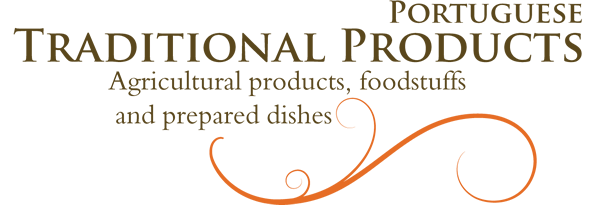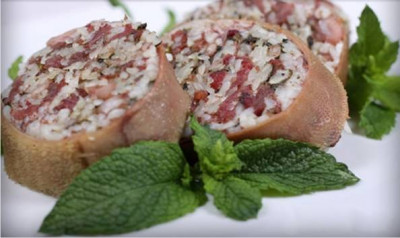Description: ‘‘Maranho da Sertã’’ means a product made from ‘bandouga’ (sheep and goat stomach), filled with a mixture of ingredients that respects the following incorporation limits (% weight):
- Goat and / or sheep meat: predominant ingredient, 20 to 40%, inclusive;
- Carolino rice: 15 to 25%, inclusive;
- Mint: 2 to 6%, inclusive;
Also included as mandatory ingredients: ‘Bandouga’, bacon, ham, olive oil (extra virgin or virgin olive oil), white wine, salt and water. Optionally, the following ingredients can also be incorporated: meat sausage, lemon juice, pepper or chilli and garlic.
Production method: ‘Bandouga’ is the common name attributed to the stomach of goats and / or sheep used as a wrapper for ‘‘Maranho da Sertã’’. The ‘bandouga’, after being cleaned and washed, must be sewn with a needle and thread, leaving an opening to introduce the filling. In the production of the filling, the following ingredients should be used: sheep and / or goat meat, carolino rice, ham, bacon, mint, olive oil, white wine, water and salt. Optionally, the following ingredients can also be used: meat sausage, pepper or chilli, lemon juice and garlic. Meat (goat and / or sheep meat, meat sausage, bacon, ham) must be cut into small pieces and mixed. The mixture, after seasoning, should be left to marinate. The rice should be drizzled with oil and added to the mixture. Once the filling is prepared, the ‘bandouga’ is filled. The ‘bandouga ‘ should only be filled to about ¾ of its capacity in order to prevent it from breaking due to the increase in rice volume during cooking.
Special features: ‘‘Maranho da Sertã ’’ has the typical shape of a stomach (like a bag or ‘C’). Its outer appearance is rough, with the alveolar texture of the ‘bandouga’ visible. It does not break and the hand-sewing is visible to the naked eye. It has a flavor where mint and goat and / or sheep meat are evident, lightened by ham and meat sausage. The aromas of mint and goat and / or sheep meat are predominant.
“Maranho da Sertã' differs by not having as an ingredient wild thyme (Thymus serpyllum), not to use synthetic bandouga and be sewn by hand with a needle and thread.
Production area: The geographical area of production, preparation and packaging of ‘‘Maranho da Sertã ’’ is limited to the Sertã Municipality.
History: “Maranho da Sertã ’’ has a great reputation, being one of the most famous products in regional cuisine. This reputation, consolidated over the years, is based on the advantage that the local know-how was able to extract from the typical ingredients of the region, giving rise to a characteristic and much appreciated product.
The first written record found on ‘maranho’, in its dietary aspect, dates from 1858 and appears in the 6th edition of the Portuguese Language Dictionary, by António da Silva Morais, where they are characterized as a “delicacy of Portuguese origin, in whose preparation includes rice (…) and lamb chops, seasoned with mint”. The appearance of the '' Maranho da Sertã '', with its own characteristics, different from those found in most traditional Portuguese sausages and bagging, is certainly related to the typical sheep and goat production in the region where the Sertã municipality is located, where the number of more than 100,000 goats and sheep was counted (Salavessa, João; “Salsicharia tradicional da Zona do Pinhal - Caracterização e melhoramento da tecnologia de fabrico dos Maranhos”; Universidade Técnica de Lisboa; Lisboa; 2009).
“Maranho da Sertã’’ gained prominence during the 20th century, being consumed mainly on feast days. A fact that reveals the regional importance of this product is related to a famous lunch offered to Afonso Costa (Minister and Prime Minister of the First Republic), on April 13, 1913, in Cernache do Bonjardim (a town located in the municipality of Sertã), where the main product presented was the already traditional ‘maranho’.
Product specification (pdf)
Producer group
APROSER - Associação de Produtores do Concelho da Sertã
Control and Certification Body
CERTIS - Controlo e Certificação, Lda.
Control Plan
Control plan (pdf)
Publication in EU official journal
Publicação de um pedido de registo - (2022/C 63/09) – 07.02.2022
JOUE L164 de 20.06.2022
Publication in the Portuguese official journal
Despacho n.º 6106/2020 – 05.06.2020



